23 Easy At-Home Workouts You Can Do During Quarantine
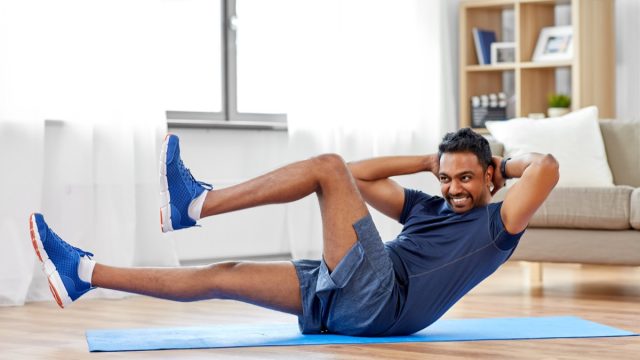
Since the COVID-19 pandemic forced businesses to close their doors and mandated that everyone stay home, it has disrupted all of our routines, including our fitness regimen. While this quarantine period has been incredibly stressful and challenging, it’s important to keep moving and maintain some semblance of our everyday activities. Fortunately, many personal trainers, gyms, and studios across the country have been offering free on-demand fitness classes and at-home workouts that people can do via Zoom, Instagram Live, and on their own online platforms.
But we know that breaking a sweat at home isn’t always convenient. There’s not as much space, and you might not own the right equipment. That’s why we tapped some of the top trainers to share their go-to bodyweight exercises, which you can easily modify with the resources you have in your house or apartment. Don’t have dumbbells or kettlebells? No problem. Load up with canned foods, water jugs, coolers, heavy backpacks, and books. Here are some easy exercises and simple stretches you can do at home. To learn which moves you should stay away from, check out the 13 Exercises You Should Avoid, According to Personal Trainers.
1
Bird Dog
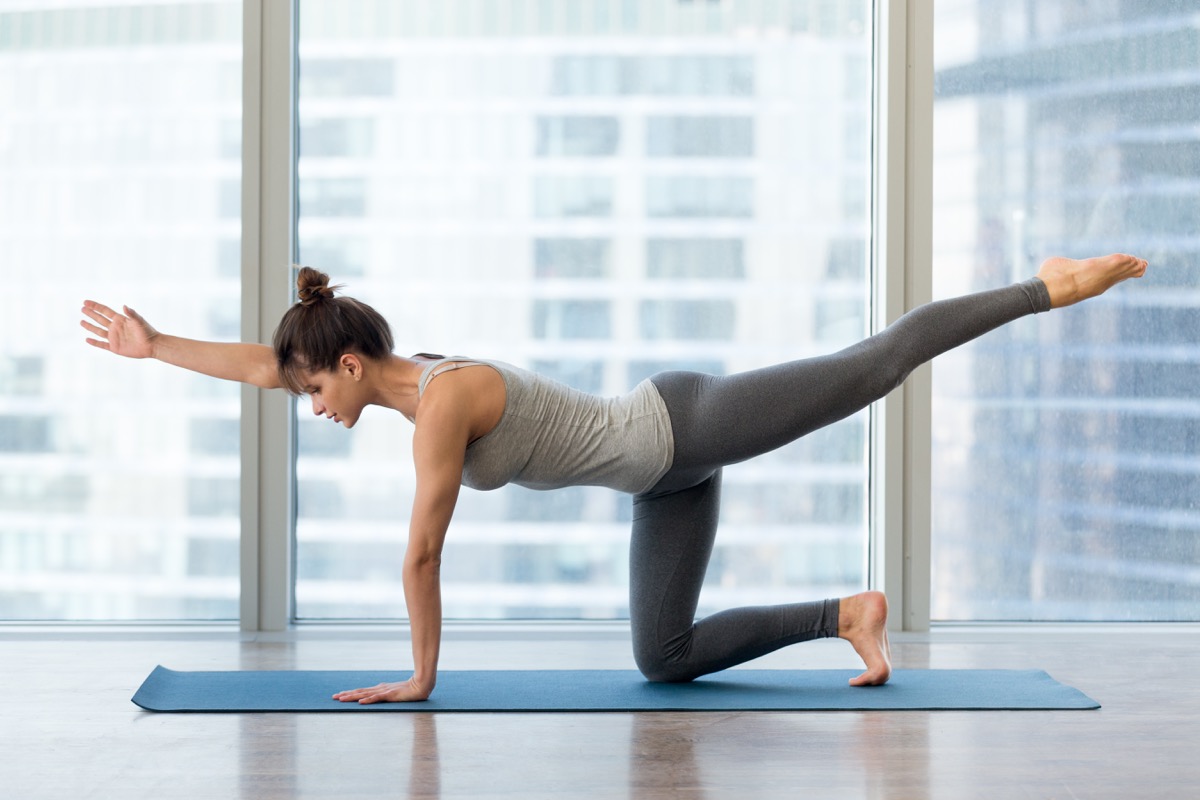
The bird dog will break up any stagnation you may be feeling from laying down on the sofa binge-watching Netflix, says Matty Maggiacomo, Peloton tread instructor. The bird dog is also great for activating the core, so it can serve as a warm-up before exercise. “Not only are bird dogs accessible, but they also promote lengthening through the joints, lower back, and core,” Maggiacomo says.
How to do a bird dog: Start in a tabletop position on an exercise mat with your shoulders directly over your wrists and hips in line with your knees. Keep a neutral spine. Reach and extend your right arm straight out in front of you, drawing your right bicep by your ear. At the same time, slowly extend your left leg out, lifting it off the mat. The goal is to create a straight line from your right fingertips to your left heel, making sure not to create unnecessary tension in the lower back. Slowly place your right hand and left knee back on the mat and then alternate sides. Do 10 reps on each side.
2
Figure 4 Crunch

You won’t think of crunches the same way again once you try this variation, which doubles as a stretch. You can easily modify it by bending both knees instead of extending the opposite leg, Maggiacomo says. “That would be my recommendation for those who experience discomfort in their lower back,” he says.
How to do a figure-4 crunch: Lie face-up on an exercise mat and draw your fingertips to your temples. Extend your right leg on the floor and bend your left leg, placing your left ankle on your right knee. Crunch your upper body up by drawing your back and shoulders off the mat. At the same time, lift your legs in a figure-4 position off the mat, drawing your chest towards your knees. To advance, twist by drawing your right elbow to your left knee. Continue for 30 seconds before alternating legs.
3
Bear Plank
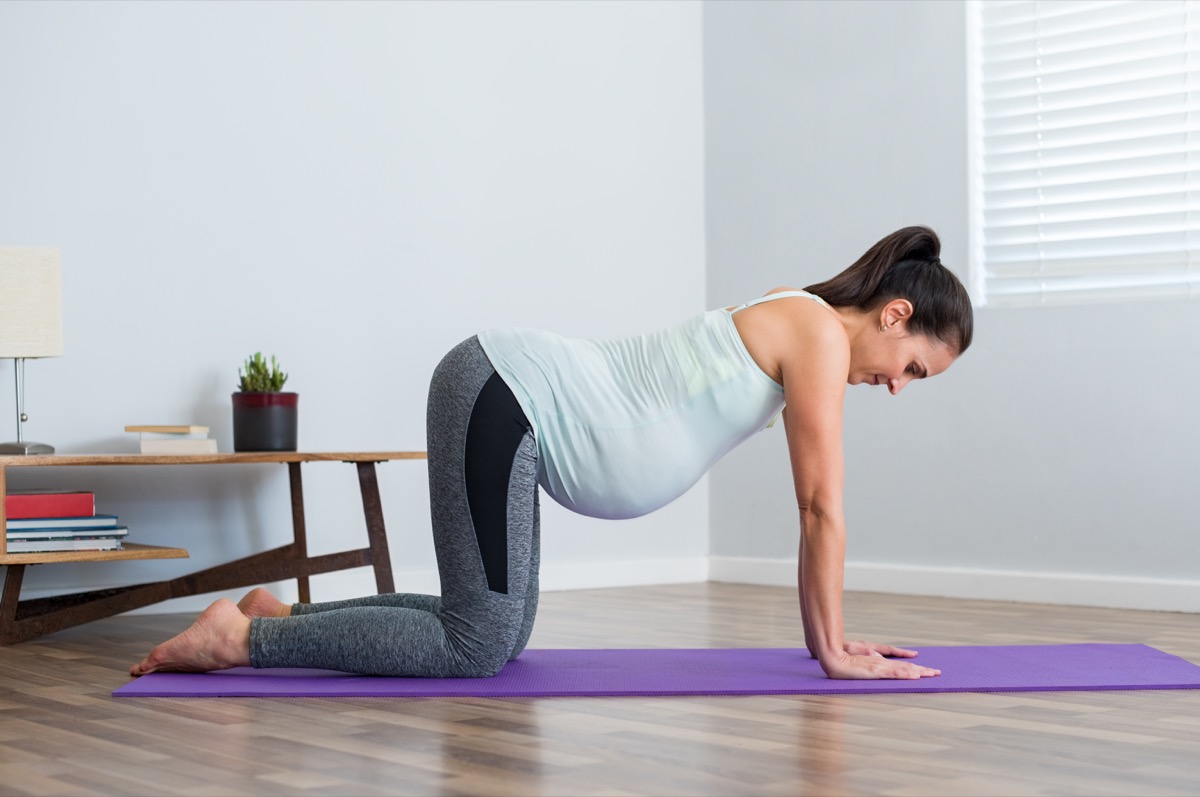
Looking to change up your plank game? Consider bear planks, which fire up your core, shoulders, and quads. “This is easily my favorite plank as it’s more interesting than a traditional plank. You can gradually progress to holding this position for longer periods of time—and it definitely sneaks up on you!” Maggiacomo says.
If you want to advance it, you can hover your knees closer to the floor and incorporate some shoulder taps, just be sure to keep your core tight so your hips stay square. An easy test is to place a yoga block on your low back. If the block moves or falls, it’s a cue to tighten up. Maggiacomo also suggests lifting one leg or one arm off the floor.
How to do a bear plank: Start in a tabletop position on an exercise mat with your shoulders directly over your wrists and hips over your knees. Press your hands into the mat and lift your knees off the floor, about four to five inches. Hold this position while maintaining a neutral spine and grip your fingers into the floor. After 10 seconds, bring your knees back on the mat and repeat four or five rounds. You can gradually increase the duration you’re holding a bear plank, working your way up to a full minute.
4
Walk-Out to Push-Up
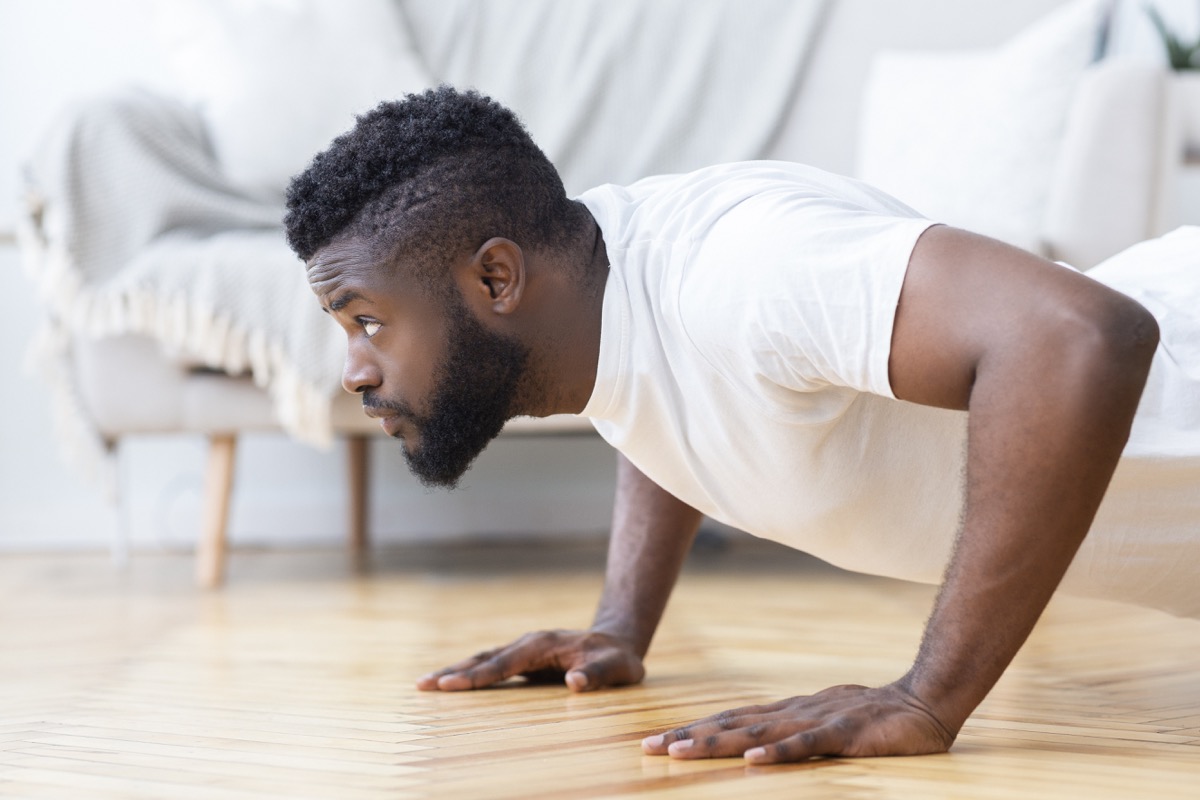
Walter Kemp, NASM-certified trainer for obé fitness, likes this combo move for toning and strengthening the core, chest, and shoulders. If you’re not able to do a regular push-up, you can drop to your knees from the high plank position.
How to do a walk-out to push-up: Start standing with your feet hip-distance apart. Bend forward at the hip and place your hands on the ground, walking them forward until you’re in a high plank position. Keeping your core, quads, and glutes tight, lower your body towards the mat until your chest and hips touch the mat, elbows pointing back at 45 degrees. Press your hands into the floor to push your body back up into a high plank. Then, walk your hands back to your feet to stand. For more work-out ideas, check out The 15 Best Exercises for People Over 50.
5
Side-to-Side Oblique Heel Touches

Your obliques, AKA side abs, are like the walls that make up your torso. Without strong walls, they aren’t able to support the low back. By strengthening the obliques, you eliminate back pain and posture issues, Kemp says.
How to do heel touches: Lie face-up on an exercise mat with knees bent and feet flat on the floor. Lift your head, neck, and shoulders off the mat coming into a crunch, reaching your arms long at the sides. Keeping your head and shoulders off the mat, reach your right fingers forward to touch your right heel and then return to center and reach your left fingers forward to touch your left heel. Continue alternating sides without lowering your shoulders or head onto the mat.
Lateral Lunge with Overhead Reach

As you’re quarantining, chances are you’re spending most of your day sitting down, but doing exercises that have you working in different planes of motion and patterns can help ease stiffness in the joints and prevent pain. Jason Loebig, a Chicago-based Nike trainer and co-founder of Live Better Co., recommends this multi-planar movement for strengthening the glutes and shoulders while working mobility in the hips and back.
How to do a lateral lunge with overhead reach: Starting with your feet together, take a big step to your right with your right foot and lower into a lunge, sending your hips back. Make sure your right knee is in line with your right ankle and your left leg is straight, both feet facing forward. From this position, extend your arms over your head while maintaining the hinge in your hips. Pause for a second to deepen the lunge and feel the stretch. Bring your arms back to your sides and push off with your right foot to straighten your leg and return to the starting position. Repeat on the left side.
7
Push-Up to Downward Facing Dog
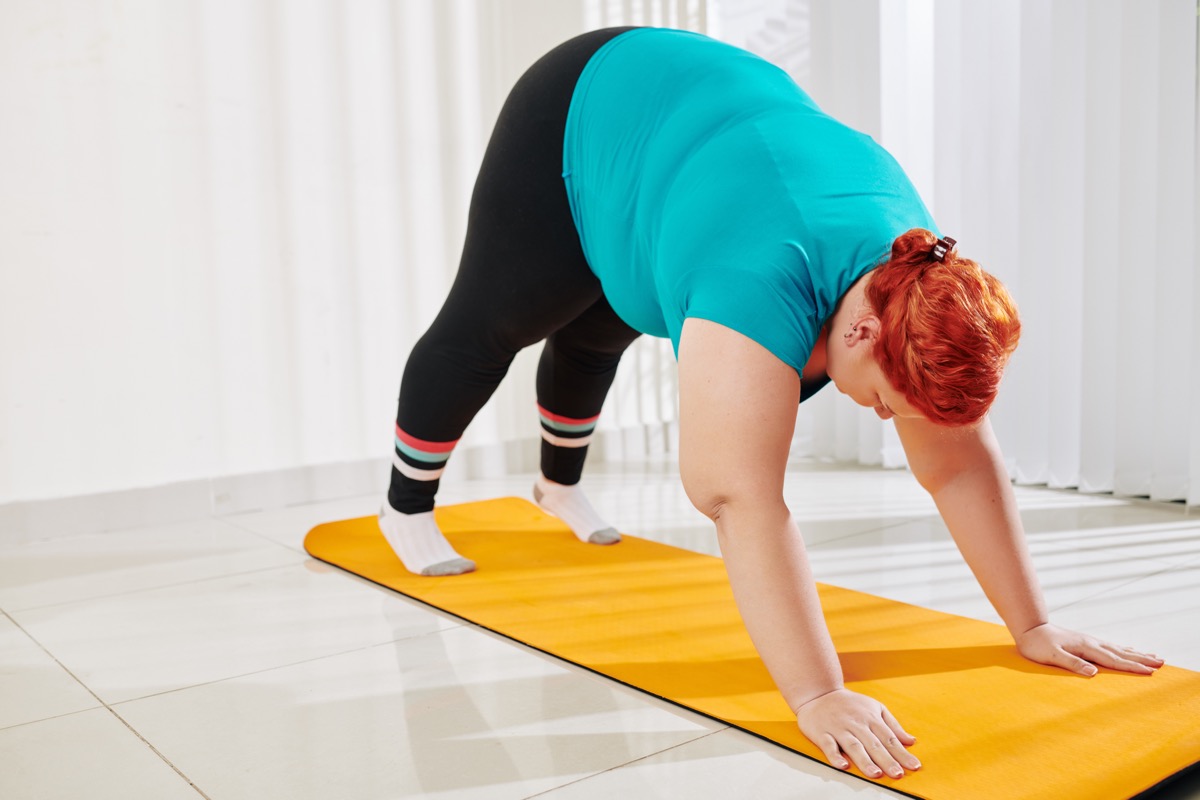
This compound exercise offers the double benefit of strength and stretch, says Loebig. “To regress the movement, try the push-ups from your knees and taking your downward dog with a bend in your knees,” he says. If you’re regressing the push-ups from your knees, make sure to still practice full range of motion by bringing your chest to the floor. Want an extra challenge? Loebig says add shoulder taps after each push-up (avoid rocking the hips) or alternate toe taps when you’re in downward facing dog.
How to do a push-up to downward facing dog: Start in a high plank, stacking your shoulders over your wrists, tucking your pelvis in and tightening your quads and glutes. Lower your body in a straight line toward the mat until your chest and hips touch it, aiming to have your elbows point back at 45 degrees and maintaining the tightness in your core and glutes. Press your hands into the floor to push your body back up into a high plank.
From a high plank, lift your hips toward the ceiling until your body forms an upside-down V. Straighten your legs and lower your heels toward the ground. Relax your head between your arms. Pause for a second and then return to the starting position in high plank. To demystify exercise, check out The 21 Biggest Exercise Myths, Debunked by Science and Health Experts.
8
Jump Rope
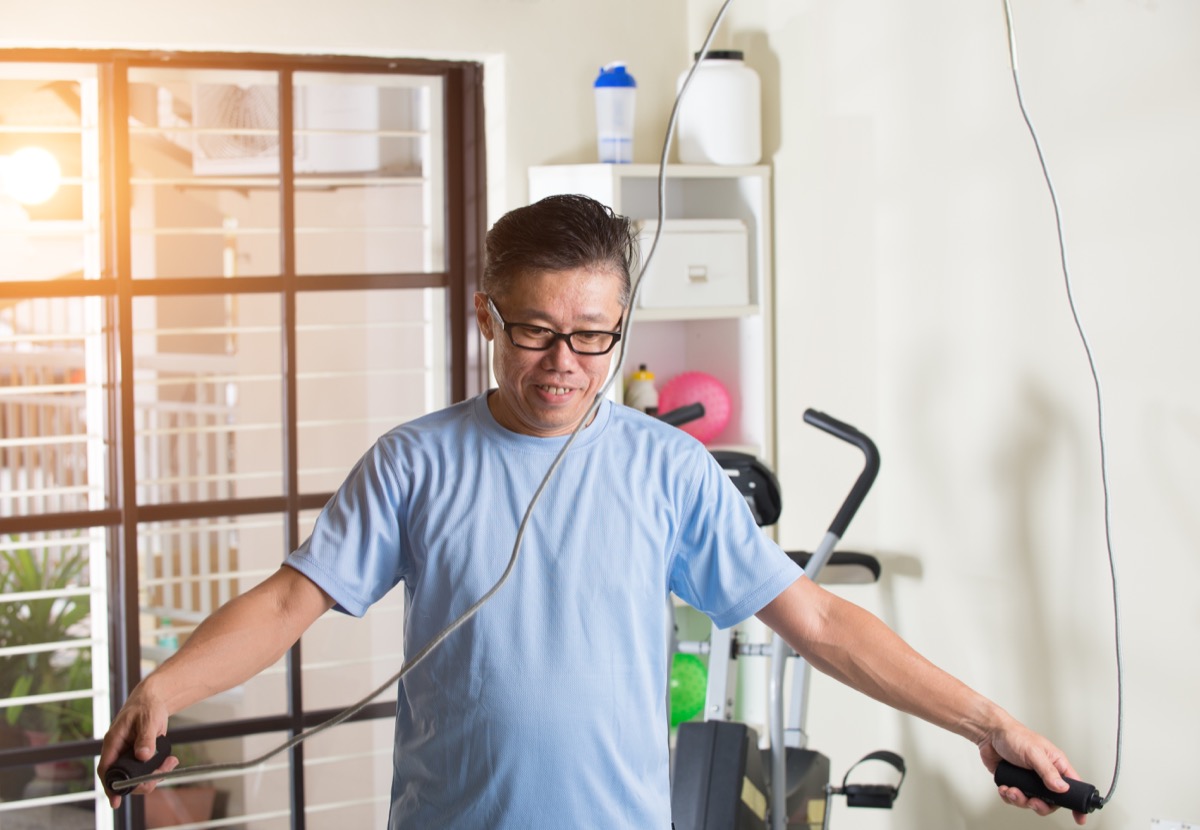
If your childhood was the last time you picked up a jump rope, then you should start hopping again now. Loebig likes this low-impact exercise for elevating the heart rate and stimulating the lymphatic system from prolonged periods of sitting. It also helps improve coordination and balance.
“If you don’t have access to a jump rope, simply stimulate the motion and jump in place,” Loebig says. To take this exercise a step further, Loebig recommends double unders or doing lateral jumps.
How to jump rope: Jumping rope comes from movement in the wrists—not the elbows and shoulders. Start with your feet together, your shoulders back and down, and your hands by your sides holding each end of the rope. Tightening your core, jump up with your feet together as you swing the rope, landing on the balls of your feet. Continue jumping rope without your heels touching the ground.
9
Glute Bridges
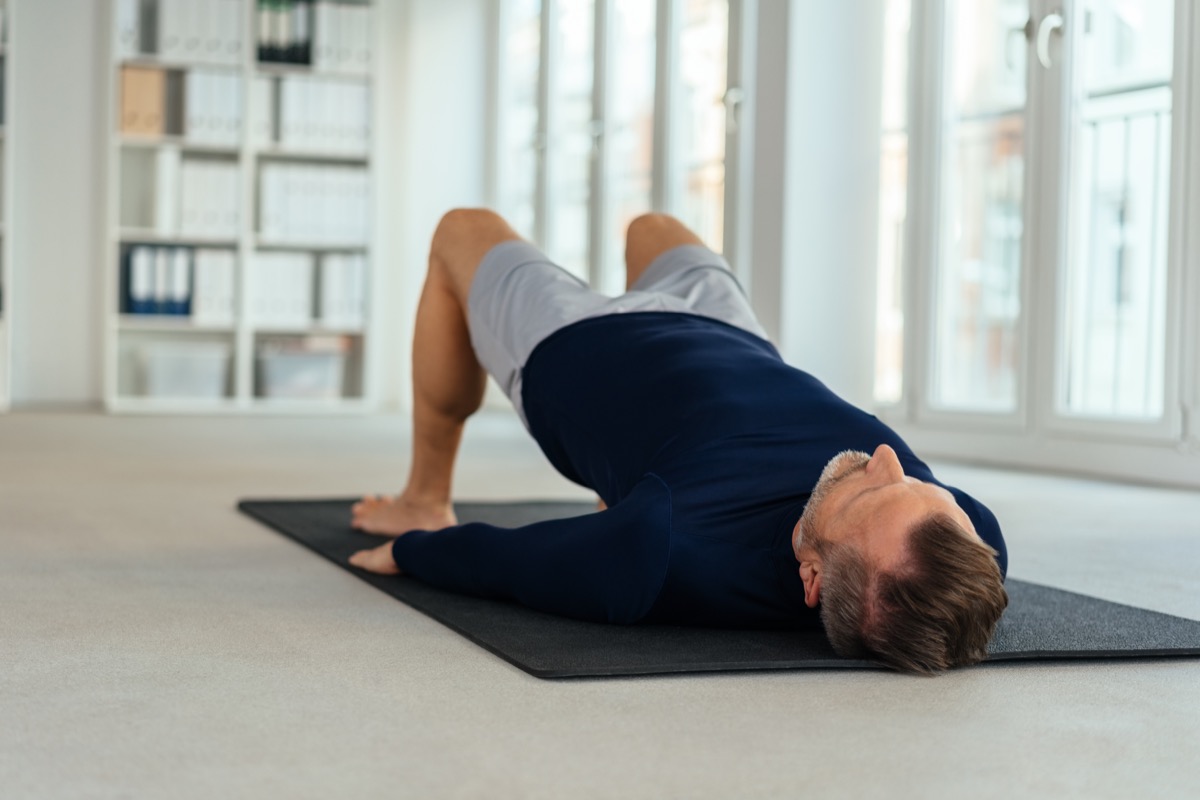
This exercise opens the hips as much as it strengthens the core, low back, and glutes, reversing the effects of time spent sitting down, says R. Alexandra Duma, DC, DACBSP, a sports chiropractor for Team USA, who practices out of FICS, a high-tech fitness recovery and wellness studio in New York City.
Glute bridges are particularly great for strengthening all three glute muscles: the gluteus maximus, gluteus minimus, and gluteus medius. Duma suggests trying single-leg bridges, resistance band bridges, and weighted bridges for other variations.
How to do a glute bridge: Lie face-up on an exercise mat with your knees bent and feet flat on the floor a few inches away from your butt. Tightening your glutes and core, lift your hips and back off the ground to form a diagonal line from your shoulders to your knees. Then, lower your butt back down to the ground.
10
Glute Bridge Walk-Out with Full Sit-Up
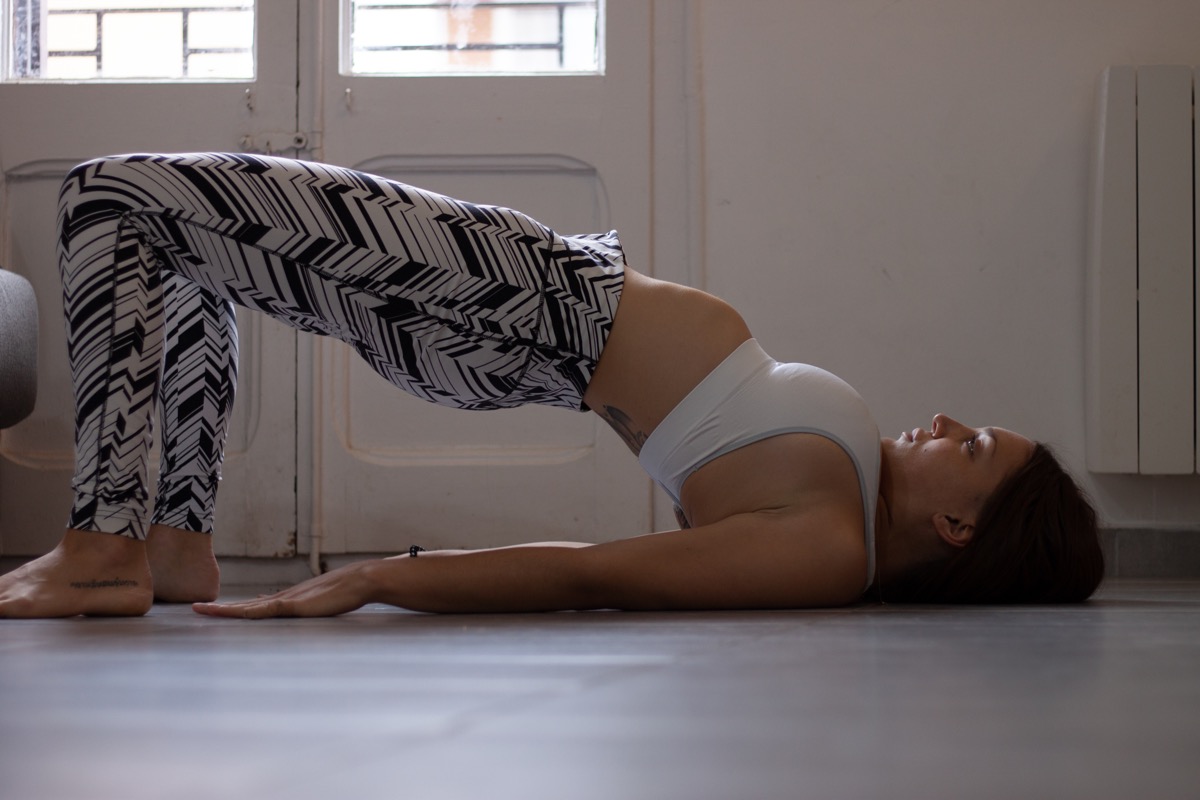
This variation of the glute bridge incorporates a sit-up to help open up the hips from sitting while also chiseling your abs, says Chris Vo, Equinox group fitness instructor on Variis, an app where you can access on-demand workouts from Equinox, SoulCycle, Pure Yoga, and more.
How to do glute bridge walk-outs with full sit-ups: Lie face-up on an exercise mat with your knees bent and feet a few inches away from your butt. Tightening your glutes and core, lift your hips and back off the ground to form a diagonal line from your shoulders to your knees. Continue to keep your hips lifted as you walk your heels out a few inches forward. Then, lower your hips down to the mat and roll up to a full sit-up with your arms overhead. Roll back down on the mat to the starting position. Prioritize full range of motion with this exercise. Faster doesn’t mean better in this case, as it will be the most beneficial to complete 20 slow and controlled reps.
11
Superman Burpees
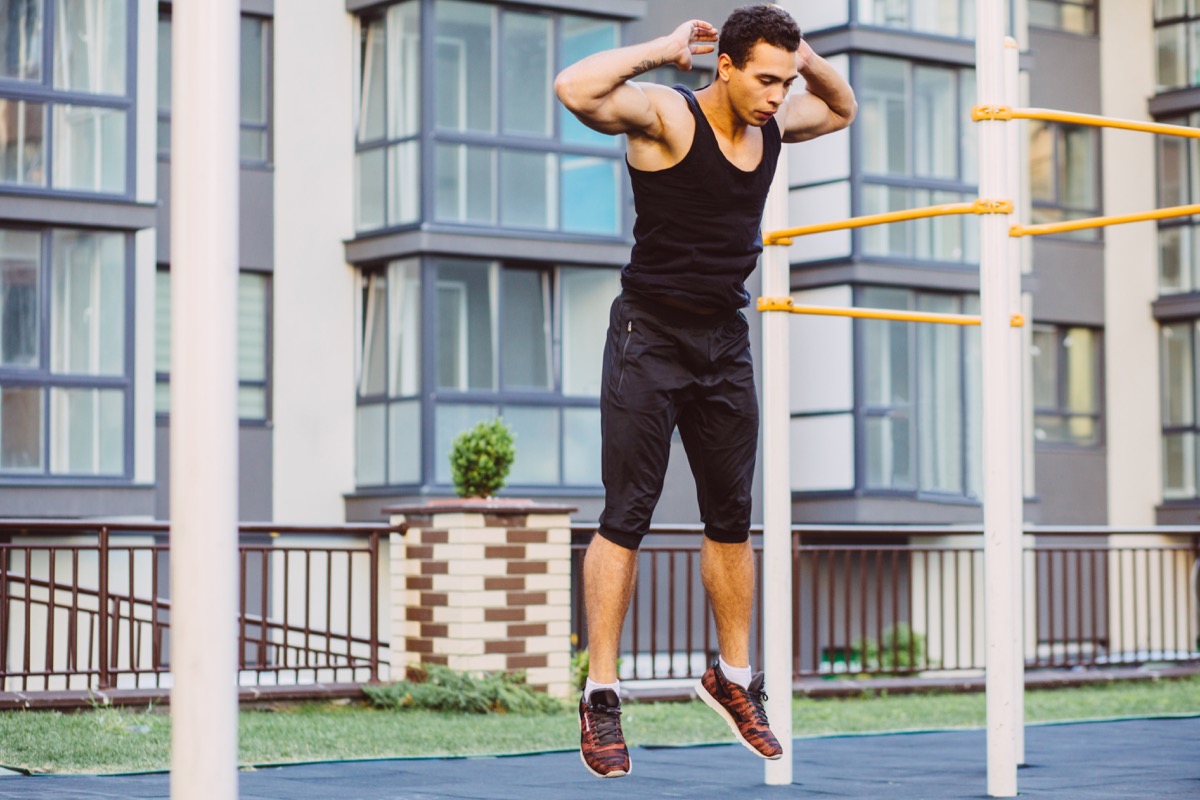
For a move that’ll get your heart racing and work every muscle in your body, try adding the superman/woman burpee. “Adding the superman position forces you to engage the posterior chain, including your shoulders, back, glutes, and hamstrings, and also increases your range of motion, whether you’re at home or the gym,” says Vo.
How to do a superman/woman burpee: Start with your feet shoulder-distance apart. Push your butt back and lower down into a squat, bringing your hands to the floor. Jump your feet back to get into a high plank position and then lower your body to the floor. From here, extend your arms in front of you and legs behind you, lifting your legs, arms, and chest off the floor in a superman position. Hold this position and pause for a second. Bring your hands by your chest and jump your feet to the outside of your hands so you land in a squat. Then, jump explosively up, firing up your glutes, and land softly back on your feet. Do as many reps as possible in a minute.
12
Speed Punches and Uppercuts

Unlike jumping, punching is a great heart-pumping move that’ll go easy on your joints, Vo says. “Practice retracting your punches back to your guard position every time you throw a punch. If every action has an equal and opposite reaction, you’ll start to feel your lats and core fire up,” he says. Remember that your punches are an extension of your back, so generate your punches from your hips and back to facilitate speed, Vo says.
How to do speed punches and uppercuts: Get into a staggered stance with one foot forward and one foot back, about hip-distance apart. Your back heel should be slightly raised off the floor for an easy push off. Begin with your fists in a “guard position” by your cheekbones, elbows relaxed in front of your ribs. Perform jab and cross punches for 100 reps, alternating extending your fists straight out in front of you with palms facing the ground. Then perform 100 uppercuts. Aim to finish your punches in under a minute.
13
Plank Walks

Moving from a high to a forearm plank, this exercise will strengthen your arms as much as it ignites your core. The key with plank walks is to move with control and to think about pushing powerfully through the elbow joint to press yourself back up to a high plank.
How to do plank walks: Start in a high plank on an exercise mat with your shoulders over your wrists and core, quads, and glutes tight. Pressing your left hand into the mat, bring your right forearm down into the mat, followed by your left forearm. Make sure to lower your hips down as well. Then, press your right hand firmly on the mat to powerfully push through your right elbow to get into a high plank, followed by your left hand. Repeat by alternating sides. Avoid rocking your hips from side to side as much as possible and think about lowering and raising your body in a straight line.
14
Squats

As one of the most versatile bodyweight exercises, squats strengthen your glutes and quads while correcting posture, if done with proper form. “Squatting is used often when doing activities, such as lifting infants, pets, household items, and so on, even getting into and up from our chairs,” says Duma.
If you want to kick your basic bodyweight squat up a notch, load it with some weight by using a dumbbell or kettlebell, or carrying a heavy backpack or a jug of water. Duma also recommends wall squats, overhead squats (with a broom), or squatting with a resistance band right above your knees.
How to do squats: Stand with your feet hip-distance apart and your hands by your sides. Sit back into your heels, pushing your butt back and down and clasping your hands by your chest. Keep your chest and back upright to prevent hunching over and press your knees out to the sides to prevent them from caving in. Push through your heels to straighten your legs and stand back up.
15
Jump Squats
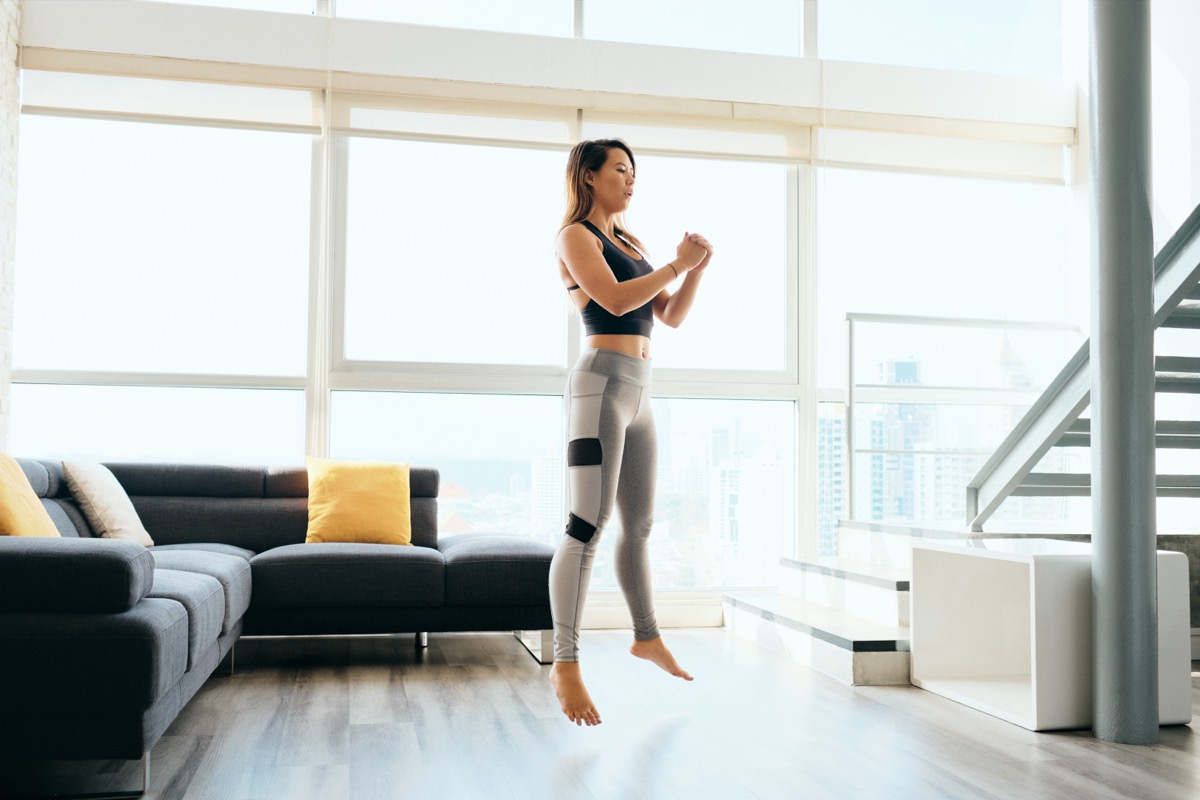
Great for increasing muscle power and firing up those fast-twitch muscle fibers, jump squats strengthen the glutes while breaking a sweat. Bodyweight too easy? You can add weight or loop a resistance band just above your knees.
How to do jump squats: Stand with your feet a little wider than shoulder-distance apart with toes pointing out to the sides. Sit back into your heels, pushing your butt back and down. Keep your chest lifted. Firing your glutes and pushing off through your legs, jump up explosively to straighten the legs and then land softly back on your heels in a squat.
16
6 O’Clock Long Leg Squeeze
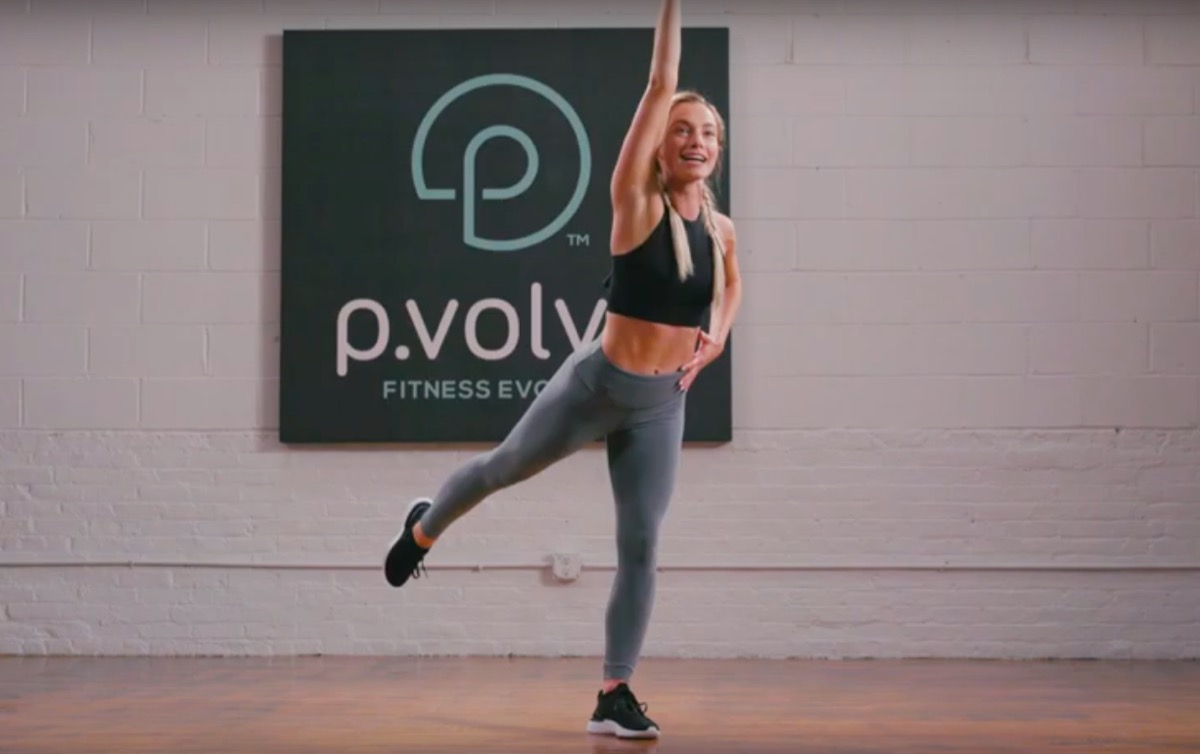
Maeve McEwen, P.volve master trainer, says this exercise is a go-to for challenging stability and actively working your core and glutes. It also helps create length throughout the entire body—a nice reprieve from being stagnant all day.
How to do a 6 o’clock long leg squeeze: Stand with one leg directly behind you at 6 o’clock and the other leg in front. Take both arms overhead, lengthening your body by actively pressing your hands through the air. Squeeze your back glute as you lift your leg off the floor. Keeping your weight on your front heel and glute, use your lower abs to pull your back knee forward and frame your knee with your hands. Then, re-engage your back glute as you lengthen the leg to the starting hovered position. Focus on stabilizing through the core, keeping the spine straight and actively pressing with your arms and leg. Do eight reps before alternating legs.
17
Forward Lunge with Rotation
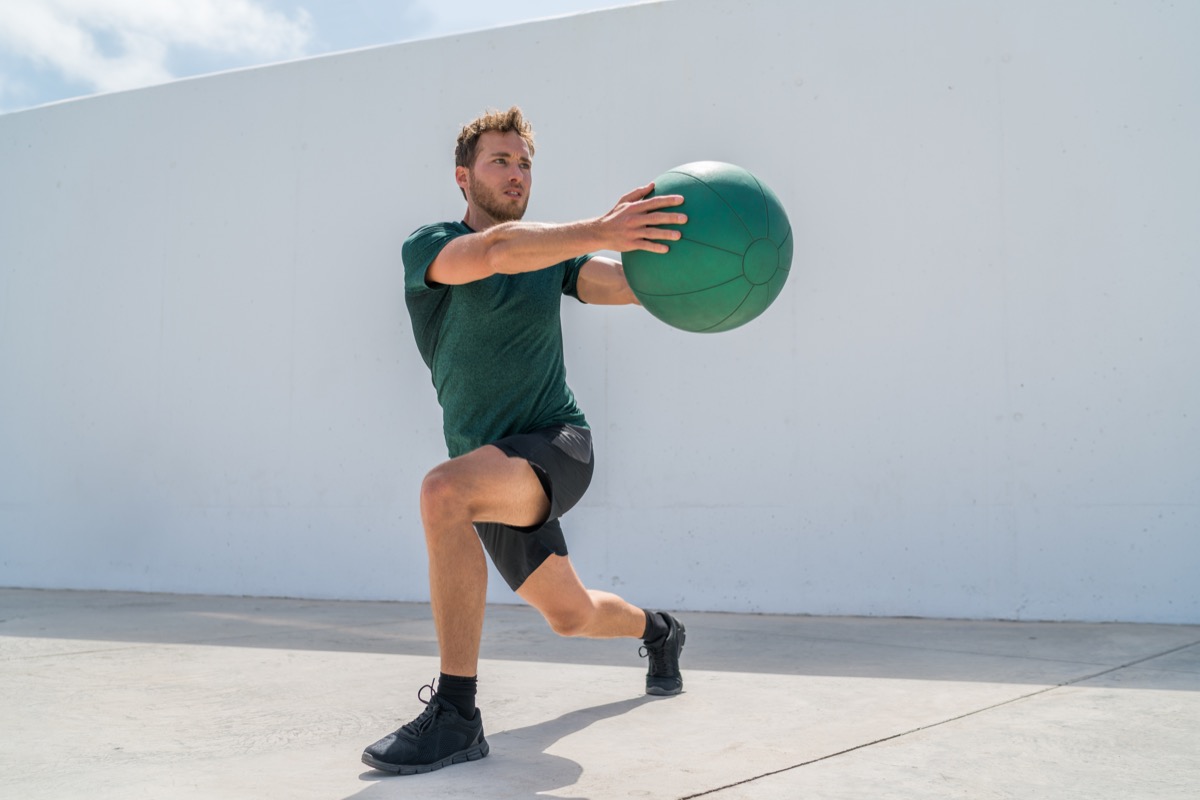
McEwen loves this exercise for its hip-opening benefits and its lesson in balance. “It focuses on transferring your weight, which trains you to move quickly and efficiently,” she says.
How to do a forward lunge with rotation: Stand with your feet hip-distance apart with a soft bend in the knees. Engaging your glutes, sit back into your heels about two to three inches, and make 90-degree angles with your arms with palms parallel to the floor. Create tension in the lats by pressing your shoulders down. Step one leg forward, loading your weight into the front heel. Press deeper into the front heel as you rotate towards the front leg and reach the opposite arm forward. Pull the back arm behind you to deepen the rotation and squeeze your inner thighs. Exhale to engage the abs. Then, shift your weight back into the standing leg by using the resistance of your low abs and squeezing your glutes. Return to the starting position. Maintain tension throughout the entire body. Alternate legs.
18
12 O’Clock Standing Abs

If you’re getting bored with planks and core exercises on your back, try this standing ab exercise. “It not only stretches the front of your standing hip and abdominals, but it also challenges your stability while firing up the obliques,” McEwen says.
How to do 12 o’clock standing abs: Starting standing with your arms behind your head and elbows bent. Tap one foot in front of you at 12 o’clock and squeeze the standing glute to stretch the standing hip. Press the pelvis forward. Continue to engage your arms and low abs and keep the spine straight. Lift the same leg just below knee height with a soft bend in the knee by contracting your abs. Rotate your torso towards your front leg as you squeeze your inner thighs. Return the leg down to the 12 o’clock tap, engaging the standing glute and lengthening through the body. Alternate legs.
19
Curtsy Lunge
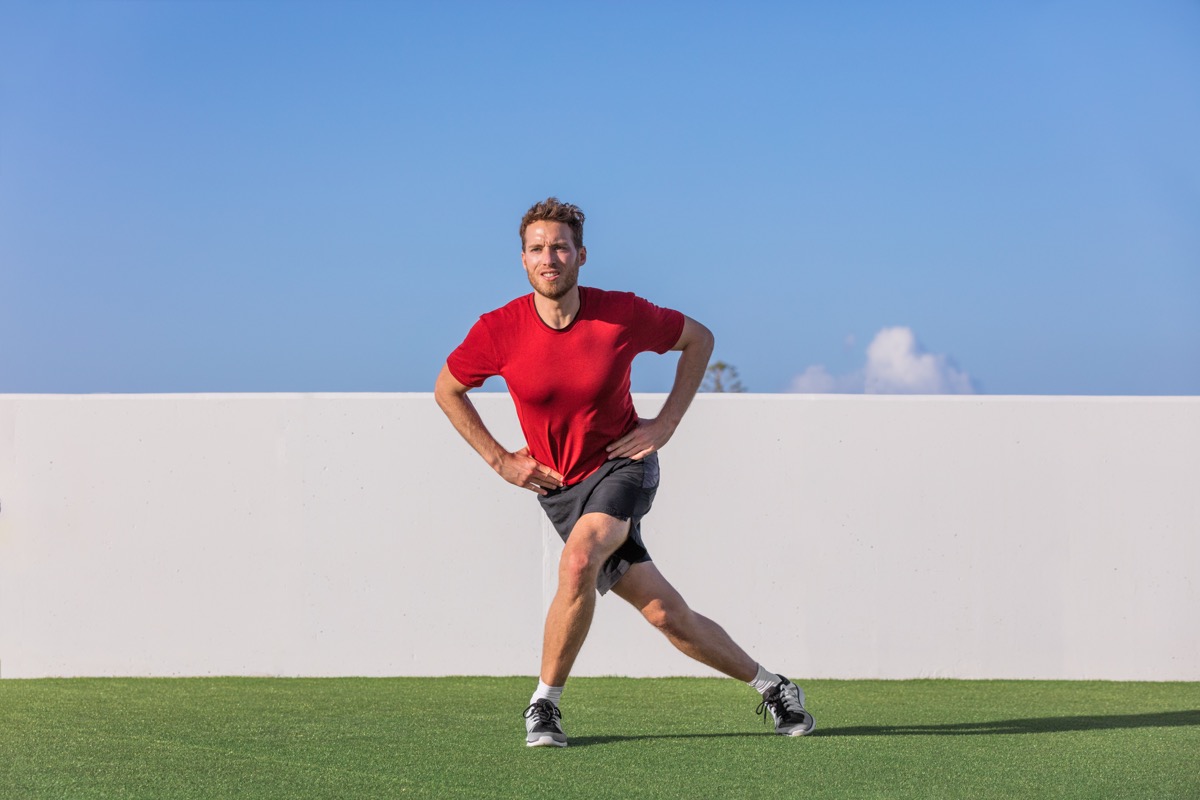
This lunge variation works your inner thighs while strengthening your quads and glutes. Remember to keep your hips and shoulders square throughout the movement.
How to do curtsy lunges: Stand with your feet hip-distance apart. Take a step behind you to your left with your right foot and lower into a lunge, forming 90-degree angles with your legs. Keep your left knee aligned with your left ankle. Push off with your legs to stand back up and continue alternating legs.
20
Wall Angels
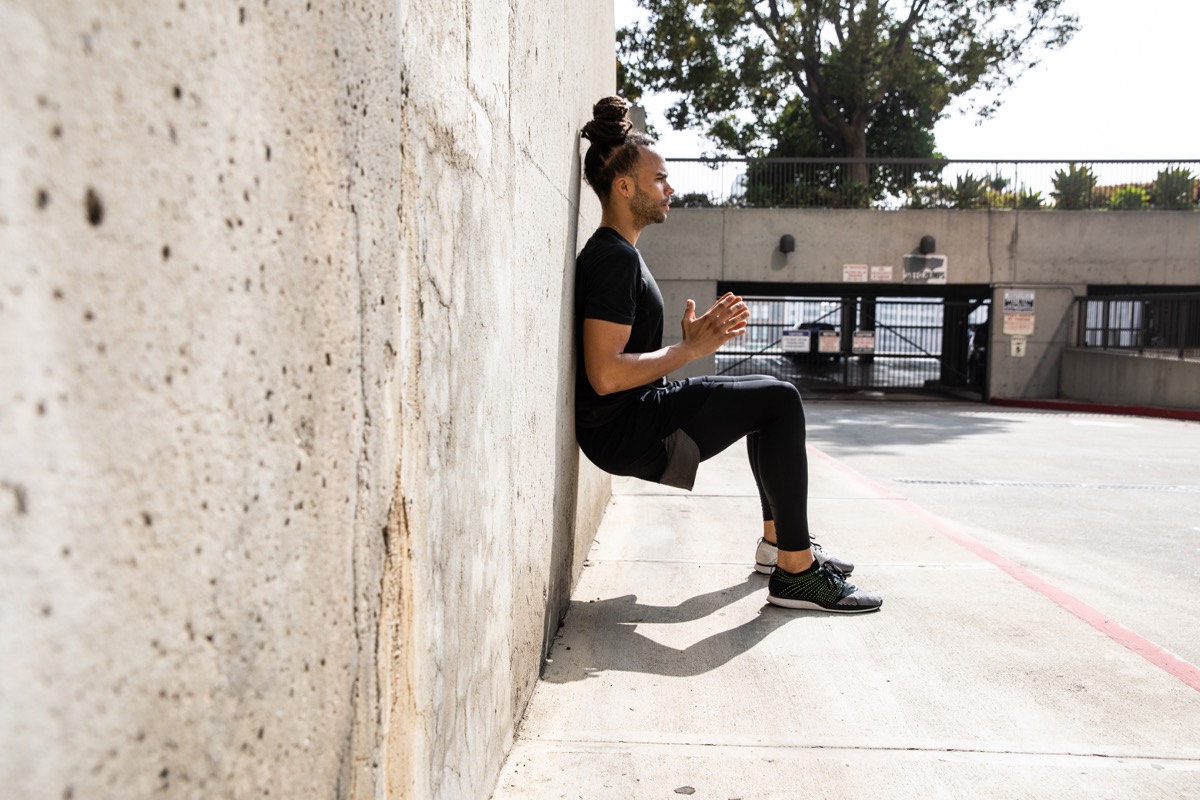
Because you’re sitting and spending more time at home, you might be in desperate need of posture-correcting exercises. Wall angels are excellent for strengthening the mid-back and improving overall posture, Duma says. “Wall angels help strengthen the shoulder and back muscles while opening up tight pectoralis (chest) muscles after working on your computer,” Duma says.
How to do wall angels: Stand with your back against a wall and bend your elbows at a 90-degree angle with your elbows parallel to the ground. Keep your heels as close to the wall as possible while making sure your hips and entire spine are pressed into the wall. Straighten your arms directly overhead, sliding the elbows up against the wall and making sure the pinky and thumb are in contact with the wall. Tighten ab muscles with the spine against the wall. If this is too difficult, you can walk your heels further away from the wall or bend the knees to get into a wall sit.
21
Hip Flexor Stretch
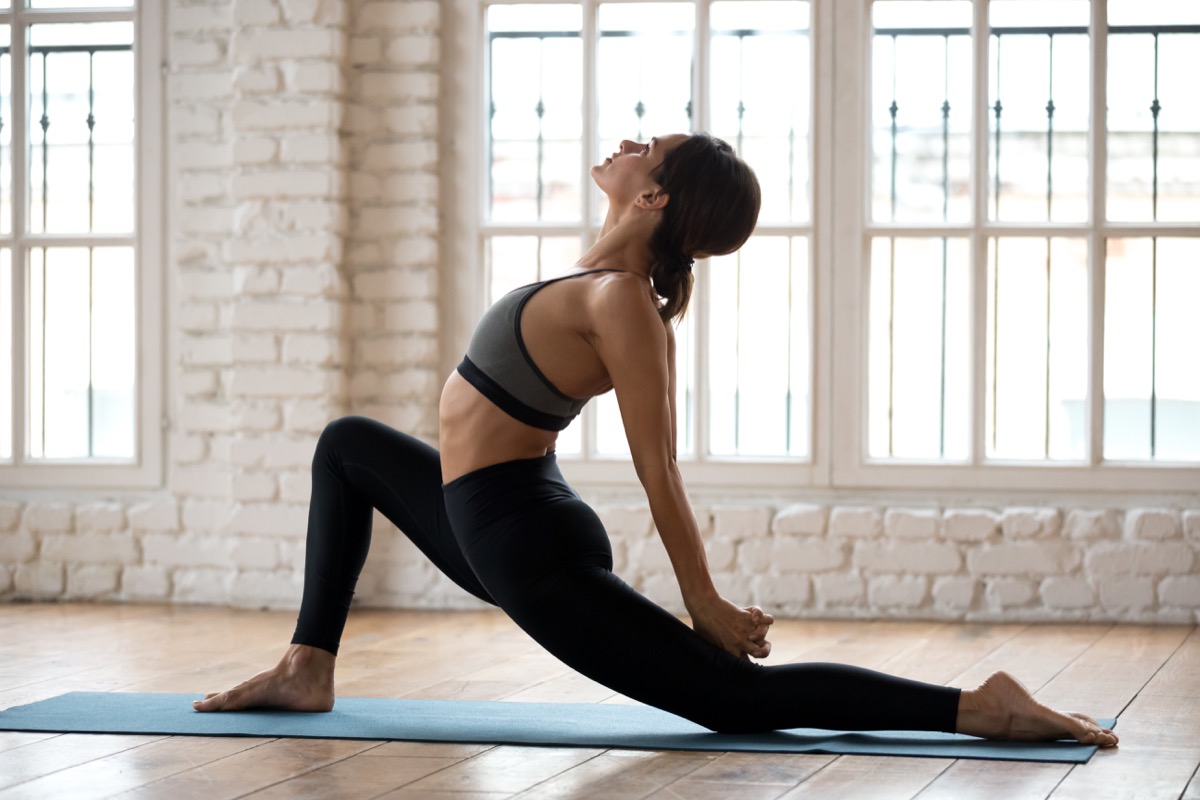
Duma recommends incorporating some stretches into your routine to keep your joints lubricated and improve mobility. This particular stretch is for your hip flexors, which can become shortened and stiff after sitting in a chair all day. “It’s very important to keep [your hip flexors] in a lengthened and stretched position as the attachments are into our low back area,” Duma says. Oftentimes, tight hip flexors are linked to low-back pain.
How to do a hip flexor stretch: Start in a half-kneeling position with your right knee in front and stacked over your right ankle, forming a 90-degree angle. Bend the left leg behind you on an exercise mat with the left knee directly under the left hip. Push your right hip forward while pressing your left knee on the mat. Hold the stretch for one or two breaths before alternating sides. Add more length by lifting an arm up and rotating to the sides.
22
Pectoralis Stretch
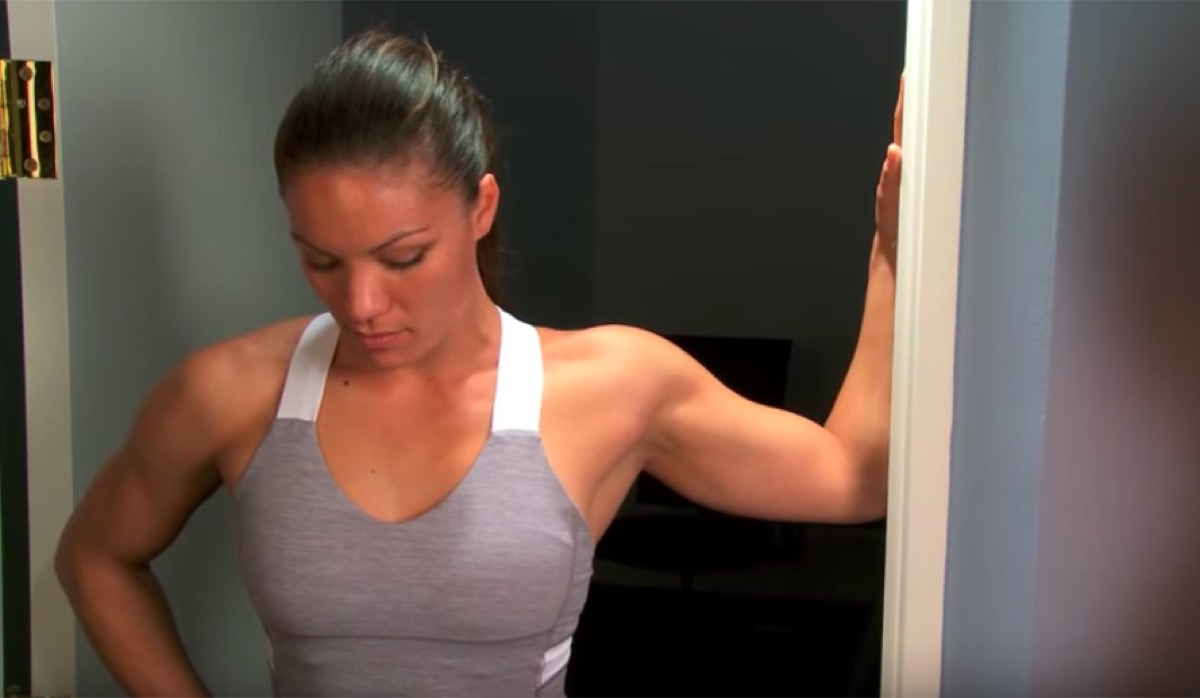
“With increased computer work, our shoulders are into what we call an internally rotated position, and the pectoralis muscles are impacted,” Duma says. When these muscles are shortened, they can cause chest pain and tightness, as well as neck pain and numbness or tingling in the upper arms.
How to do a pectoralis stretch: Stand in a split stance in front of a doorway with one foot in front of the other. Place the opposite hand and arm against the wall, forming a 90-degree angle, while the other arm rests by your side. Press your chest through the open doorway to feel the pec stretch, modifying the angle of your arm to stretch different areas of the chest. Switch sides.
23
Knees to Chest
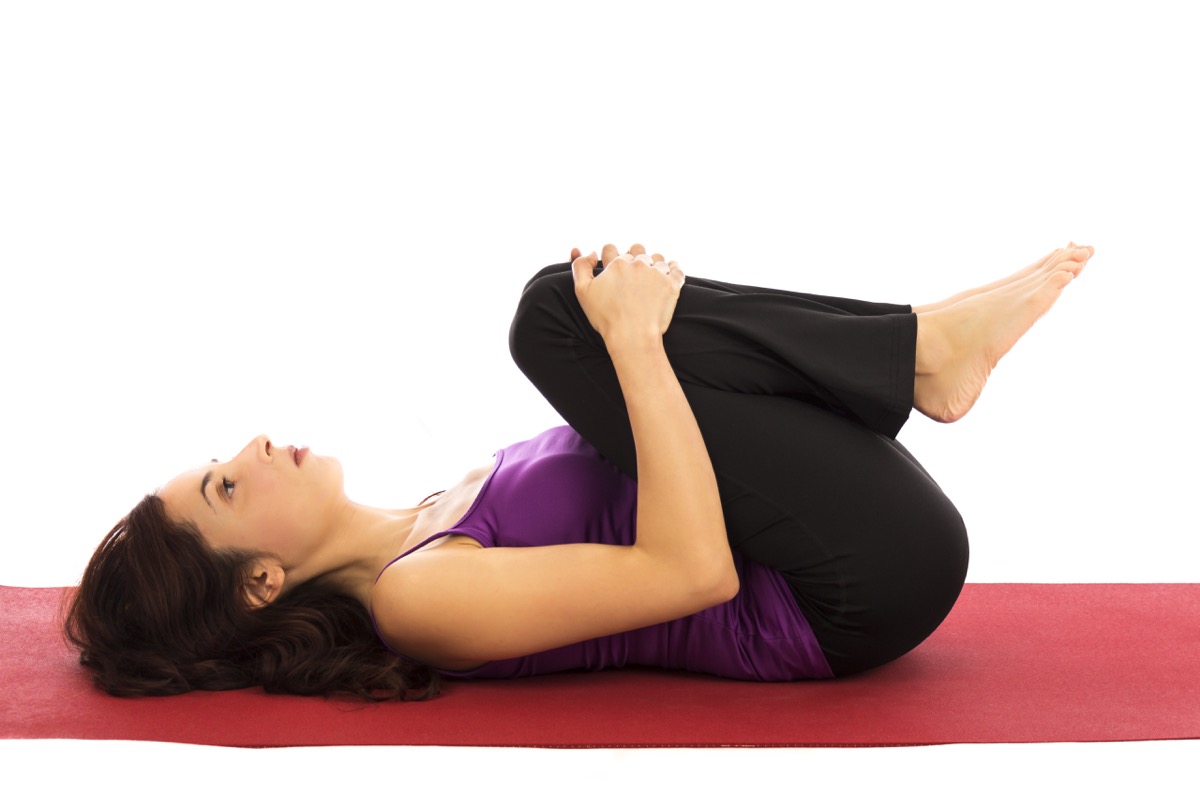
This stretch is great for massaging the low back and relaxing the hips, thighs, and glutes, Duma says.
How to do a knees to chest stretch: Lie face-up on an exercise mat and bring one knee towards your chest and then the other, wrapping your arms around your shins and tucking your chin in. Gently move your knees left to right and roll your spine up and down. You can make this a single-leg stretch by bringing one knee in towards your chest. “More intensity can be added by bringing the knee towards the opposite shoulder,” Duma says.